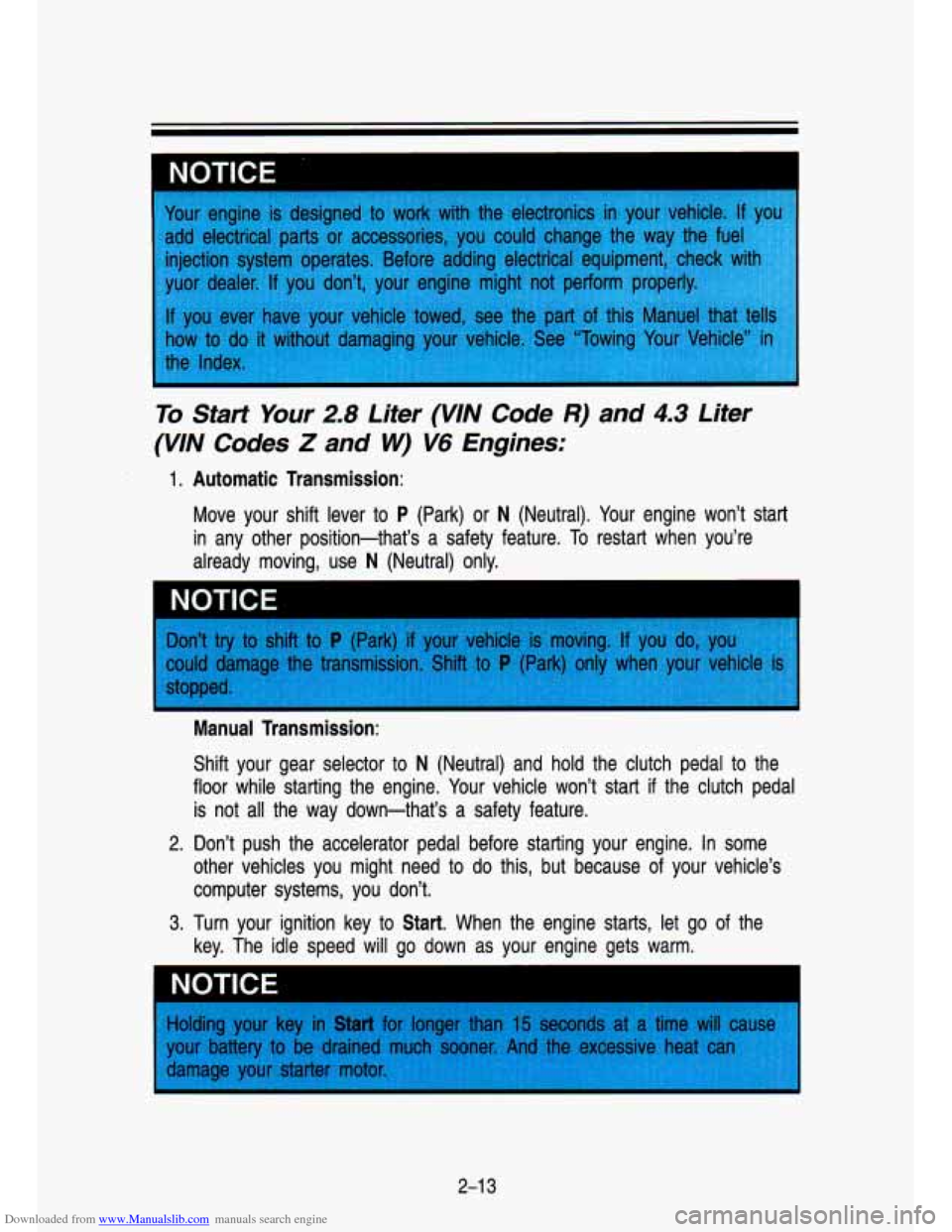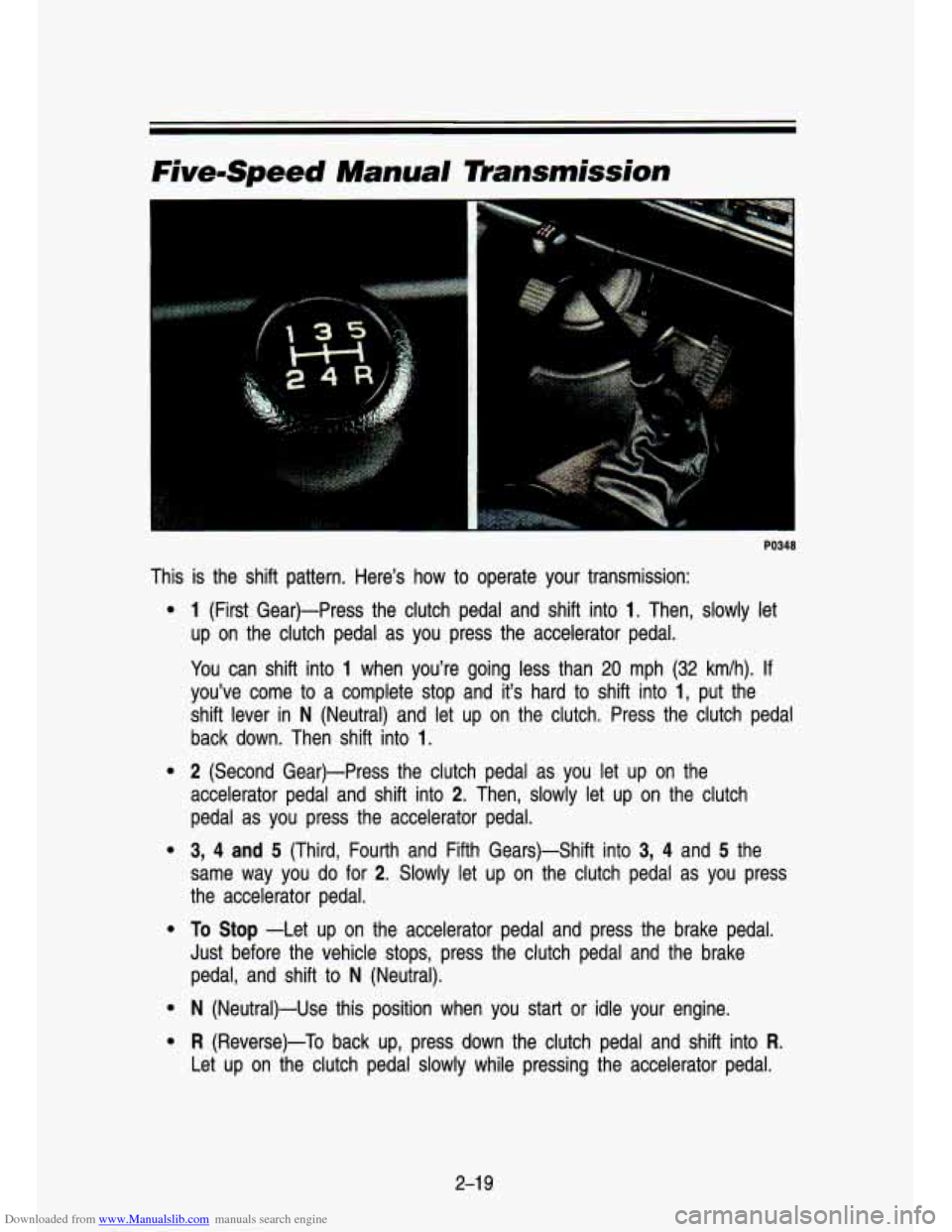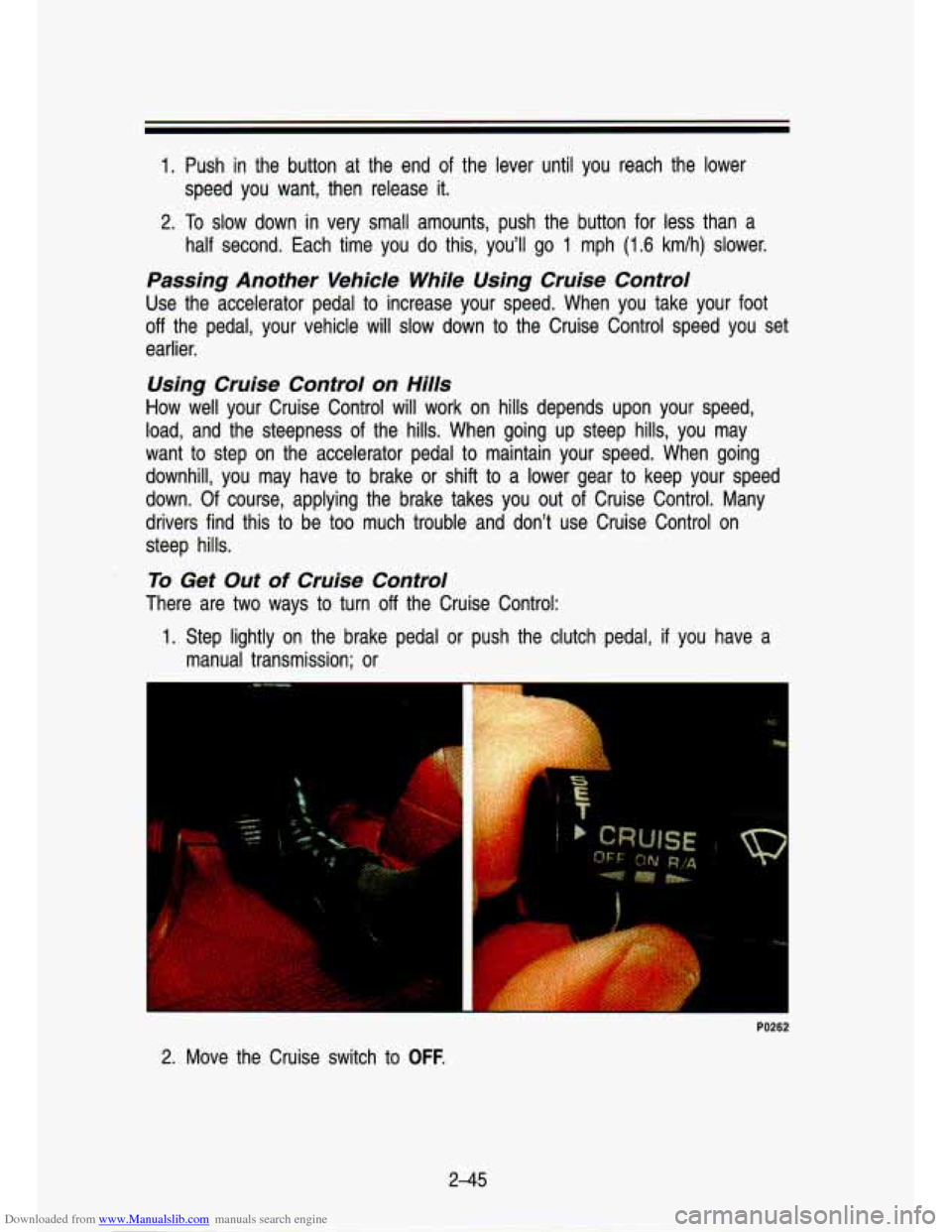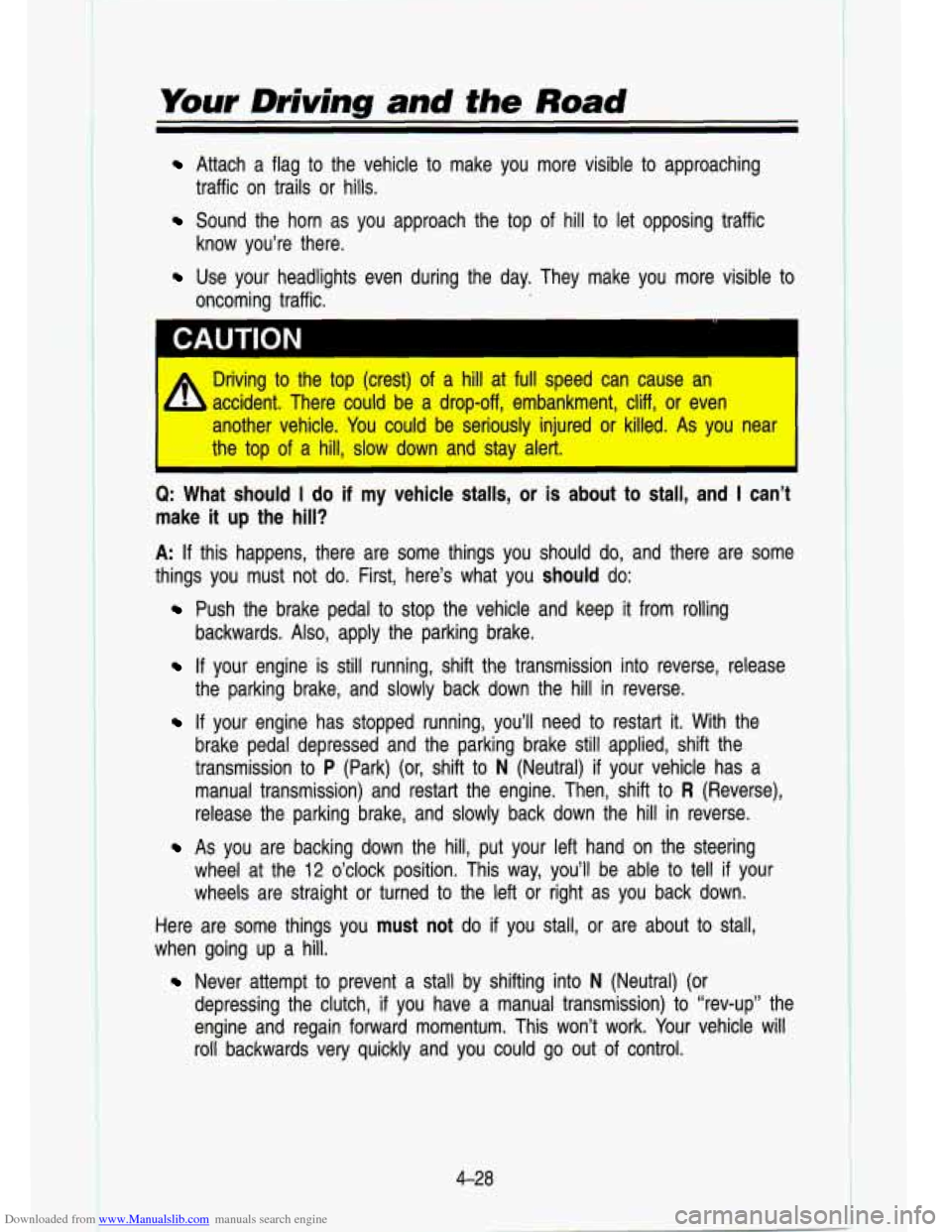1993 CHEVROLET S10 clutch
[x] Cancel search: clutchPage 64 of 356

Downloaded from www.Manualslib.com manuals search engine ..
Features & Controls
1 NOTICE
Don’t try to shift to P (Park) if your vehicle is movi
:auld dal ae ? transrnissil SI ark‘ nE
Manual Transmission:
Shift your gear selector to
N (Neutral) and hold the clutch pedal to the
floor while starting the engine. Your vehicle won’t start
if the clutch pedal
is not all the way down-that’s a safety feature.
other vehicles you might need to
do this, but because of your vehicle’s
computer systems, you don’t.
key. The idle speed will
go down as your engine gets warm.
2. Don’t push the accelerator pedal before starting your engine.\
In some
-
3. Turn your ignition key to Start. When the engine starts, let go of the
In very cold weather,
do this:
1. With your foot off the accelerator pedal, turn your ignition key to Start
until your engine begins firing. Push down on the accelerator pedal
slightly. When the engine picks up speed, let go of the key. \
Once your
engine is running smoothly, let up on the accelerator pedal.
2. If it doesn’t start right away, push the accelerator pedal all the way to
the floor and hold it there as you hold the key in
Start for about three
seconds.
If the vehicle starts briefly but then stops again, do the same
thing, but this time keep the pedal down until your engine ru\
ns smoothly.
NOTICE b___
2-1 2
t
Page 65 of 356

Downloaded from www.Manualslib.com manuals search engine NOTICE
I
ever nave your venue loweu, see 11
now IO do it without damaging your v-’-’cle
the Index.
To Start Your 2.8 Liter (W/V Code R) and 4.3 Liter
(VlN Codes Z and W) V6 Engines:
1. Automatic Transmission:
Move your shift lever to
P (Park) or N (Neutral). Your engine won’t start
in any other position-that’s a safety feature. To restart when you’re
already moving, use
N (Neutral) only.
I NOTICE
Manual Transmission:
Shift your gear selector to
N (Neutral) and hold the clutch pedal to the
floor while starting the engine. Your vehicle won’t start
if the clutch pedal
is not all the way down-that’s a safety feature.
other vehicles you might need to
do this, but because of your vehicle’s
computer systems, you don’t.
key. The idle speed will go down as your engine gets warm.
2. Don’t push the accelerator pedal before starting your engine. In some
3. Turn your ignition key to Start. When the engine starts, let \
go of the
I
2-1 3
Page 71 of 356

Downloaded from www.Manualslib.com manuals search engine FivemSpeed Manual Transmission
PO348
This is the shift pattern. Here’s how to operate your transmission:
e
e
e
e
e
e
1 (First Gear)-Press the clutch pedal and shift into 1. Then, slowly let
up on the clutch pedal as you .press the accelerator pedal.
You can shift into
1 when you’re going less than 20 mph (32 km/h). If
you’ve come to a complete stop and it’s hard to shift into 1, put the
shift lever in
N (Neutral) and let up on the clutch. Press the clutch pedal
back down. Then shift into
1.
2 (Second Gear)-Press the clutch pedal as you let up on the
accelerator pedal and shift into
2. Then, slowly let up on the clutch
pedal as you press the accelerator pedal.
3, 4 and 5 (Third, Fourth and Fifth Gears)-Shift into 3, 4 and 5 the
same way you do for
2. Slowly let up on the clutch pedal as you press
the accelerator pedal.
To Stop -Let up on the accelerator pedal and press the brake pedal.
Just before the vehicle stops, press the clutch pedal and the \
brake pedal, and shift to
N (Neutral).
N (Neutral)-Use this position when you start or idle your engin\
e.
R (Reverse)-To back up, press down the clutch pedal and shift into R.
Let up on the clutch pedal slowly while pressing the accelerat\
or pedal.
2-1 9
Page 82 of 356

Downloaded from www.Manualslib.com manuals search engine t
Featums & Contmls
2. 4HI: This setting engages your front axle to help drive your \
vehicle. Use 4HI when you need extra traction, such as on snowy or ic\
y roads,
or in most off-road situations.
3. 4LO: This setting also engages your front axle to give you extra traction.
You may never need 4LO. It sends the maximum power to
all four
wheels. You might choose 4L0
if you were driving off-road in sand,
mud, or deep snow and climbing or descending steep hills.
Indicator lights on the switch show you which setting you are \
in. Both
indicator lights
will come on briefly when you turn on the ignition. If both
lights
do not come on, you should take your vehicle in for service. The 4HI
position has a green indicator light and the 4LO position has \
an amber
indicator light. When shifting from 4HI to 4LO or 4LO to 4HI,\
the indicator
light will flash until the shift is completed.
Two-Wheel Drive, “TWO WHEEL”, does not have a switch posi\
tion or an indicator light. Your vehicle will be in
two wheel drive if neither indicator light
is on.
To shift from two-wheel drive,
“TWO WHEEL”, to 4HI: Press and release
the 4HI switch. This can be done at any speed, and the front\
axle will lock
automatically.
To shift from 4HI to two-wheel drive, “TWO WHEEL”: Press and\
release
the 4HI switch. This can be done at any speed, and the front\
axle will unlock
automatically.
To shift from two-wheel drive, ‘‘TWO WHEEL”, or 4HI to 4LO: Stop your
vehicle. Shift your transmission into
N (Neutral) or depress your clutch pedal.
Press and release the 4LO switch. You must wait for the amber 4LO
indicator light to stop flashing and go solid amber before shi\
fting your
transmission into gear or releasing the clutch pedal.
If the 4L0 switch is pressed when your vehicle is in gear and/or moving, the
amber 4L0 indicator light will flash for
30 seconds and not complete the shift
unless your vehicle is below
3 mph and the transmission is in N (Neutral) or
the clutch pedal depressed.
On automatic transmission equipped vehicles:
If your transfer case does not
shift into 4L0, your transmission indicator switch may require adjustment. With
your transmission in
N (Neutral), press and release the 4LO switch. While the
amber 4LO indicator light is flashing, shift your transmission \
into
P (Park).
Wait until the 4LO indicator light goes solid amber before shifting your
transmission into gear. This will get you into 4L0, but you should take your
vehicle in for service
so normal operation can be restored.
2-30
Page 83 of 356

Downloaded from www.Manualslib.com manuals search engine To shift from 4LO to 4HI: Stop your vehicle. Shift your transmission into N
(Neutral) or depress your clutch pedal. Press and release the\
4HI switch. You
must wait for the green 4HI indicator light to stop flashing \
and go solid green
before shifting your transmission into gear or releasing the clutch pedal.
If the 4HI switch is pressed wh’en your vehicle is in gear and/or moving, the
green 4H1 indicator light will flash for
30 seconds but not complete the shift
unless the vehicle is below
3 mph and the transmission is in N (Neutral) or
the clutch pedal depressed.
On automatic transmission equipped vehicles:
If your transfer case does not
shift into- 4HI, your transmission indicator switch may require adjustment. With
your transmission in
N (Neutral), press and release the 4HI switch. While the
green 4HI indicator light
is flashing, shift your transmission into P (Park). Wait
until the 4HI indicator light goes solid green before shifting \
your transmission
into gear. This will get you into 4HI, but you should take your vehicle \
in for
service
so normal operation can be restored.
To shift from 4LO to two-wh’eel drive, “lW0 WHEEL”: You must shift from
4LO to 4HI before shifting back into two-wheel drive.
Windows
To open your manual windows, turn the hand crank on each door to raise or
lower your side door windows.
If you have the optional power windows, the co’ntrols are on e\
ach of the side
doors.
The driver’s door has a switch for the passenger windows as\
well. Your
power windows
will only work when the ignition has been turned to Run.
231
Page 93 of 356

Downloaded from www.Manualslib.com manuals search engine I 1OTICE
Cruise Control (Option)
PO259
With Cruise Control, you can maintain a speed of about 25 mph (40 km/h) or
more without keeping your foot on the accelerator. This can re\
ally help on
long trips. Cruise Control does not work at speeds below about\
25 mph (40
kmlh).
When you apply your brakes
or push the clutch pedal, if you have a manual
transmission, the Cruise Control shuts
off.
2-4 1
Page 97 of 356

Downloaded from www.Manualslib.com manuals search engine 1. Push in the button at the end of the lever until you reach the lower
2. To slow down in very small amounts, push the button for less than a
speed you want, then release
it.
half second. Each time you do this, you’ll go 1 mph (1.6 km/h) slower.
Passing Another Vehicle While Using Cruise Control
Use the accelerator pedal
to increase your speed. When you take your foot
off the pedal, your vehicle will slow down to the Cruise Control speed you set
earlier.
Using Cruise Control on Hills
How well your Cruise Control will work on hills depends upon \
your speed,
load, and the steepness of the hills. When going up steep hills, you may
want to step on the accelerator pedal to maintain your speed. When going
downhill, you may have to brake or shift to a lower gear to keep your speed
down.
Of course, applying the brake takes you out of Cruise Control. Many
drivers find this to be too much trouble and don’t use Cruise Control on
steep hills.
To Get Out of Cruise Control
There are two ways to turn off the Cruise Control:
1. Step lightly on the brake pedal or push the clutch pedal, if you have a
manual transmission; or
ruzw
2. Move the Cruise switch to OFF.
2-45
Page 182 of 356

Downloaded from www.Manualslib.com manuals search engine Your Driving and the Road
Attach a flag to the vehicle to make you more visible to approaching
traffic on trails or hills.
Sound the horn as you approach the top of hill to let opposing traffic
know you’re there.
Use your headlights even during the day. They make you more v\
isible to
oncoming traffic.
* Drivilng to the top (crest) of a hill at full speed can cause an
I accident. There could be a drop-off, embankment, cliff, or even
another vehicle. You could be seriously injured or killed.
As you near
the
top of a hill, slow down and stay alert. I
Q: What should I do if my vehicle stalls, or is about to stall, and I can’t
make
it up the hill?
A: If this happens, there are some things you should do, and there are some
things you must not
do. First, here’s what you should do:
Push the brake pedal to stop the vehicle and keep it from rolling
backwards. Also, apply the parking brake.
If your engine is still running, shift the transmission into rever\
se, release
the parking brake, and slowly back down the hill in reverse.
If your engine has stopped running, you’ll need to restart it. With the
brake pedal depressed and the parking brake still applied, shift the
transmission
to P (Park) (or, shift to N (Neutral) if your vehicle has a
manual transmission) and restart the engine. Then, shift
to R (Reverse),
release the parking brake, and slowly back down the hill in reverse.
As you are backing down the hill, put your left hand on the \
steering
wheel at the
12 o’clock position. This way, you’ll be able to tell if your
wheels are straight or turned
to the left or right as you back down.
Here are some things you must not
do if you stall, or are about to stall,
when going up a hill.
Never attempt to prevent a stall by shifting into N (Neutral) (or
depressing the clutch,
if you have a manual transmission) to “rev-up” the
engine and regain forward momentum. This won’t work. Your vehicle will
roll backwards very quickly and you could go out of control.
4-28
I